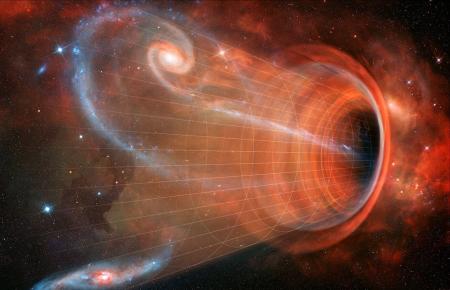Black holes grow by feeding on material their intense gravitational fields pull toward them. That incoming meal collects into a disk of hot gas and dust — one that flickers like a campfire. Astronomers have now found that monitoring changes in those flickers can reveal something that has proven very hard to measure: the behemoth’s heft. “It’s a new way to weigh black holes,” says Colin Burke. He’s an astronomer at the University of Illinois at Urbana-Champaign. This method could be used to measure any celestial object with an accretion disk, his team says. It may even help turn up long-sought midsize black holes. Burke’s team described its new technique August 13 in Science. Explainer: What are black holes? It’s not easy to measure a black hole’s mass. To start, these dark giants are truly hard to see. But sometimes a black hole will reveal itself as it dines. As gas and dust falls into it, that material organizes into a disk. Along the way, that material will heat to white-hot temperatures. In some cases, this disk can outshine all the stars combined that reside in the black hole’s host galaxy. There’s another way to measure a black hole. Its diameter can reveal its mass using Einstein’s general theory of relativity. But only the globe-spanning Event Horizon Telescope has made been able to make this sort of measurement. And so far, it’s done it for only one black hole. Other black holes have been weighed via observations of their influence on the material around them. But that takes a lot of data and doesn’t work for every supermassive black hole. Hoping to find another way, Burke’s team turned to accretion disks. Educators and Parents, Sign Up for The Cheat Sheet Weekly updates to help you use Science News for Students in the learning environment Those mysterious flickers Astronomers aren’t sure why the disks of black holes flicker. It seems like small changes in light combine to brighten or dim the whole disk over a span of time. Previous research had hinted that the time it takes a disk to fade, brighten and fade again is related to the mass of its hungry black hole. But those claims were controversial. They also didn’t cover the full range of black hole masses, Burke says. So he and some colleagues assembled observations of 67 actively feeding black holes. The mass of each was already known. Their masses spanned from 10,000 to 10 billion times that of our sun. For the smallest of these black holes, the flickers changed on timescales of hours to weeks. Supermassive black holes, having masses between 100 million and 10 billion times that of the sun flickered more slowly. The time for each flicker might last a few hundred days. That was the hint, says Burke. If this relation holds for the full range of supermassive black holes, he says — from small to big ones — then “maybe it’s sort of a universal feature.” Let’s learn about black holes Out of curiosity, his team also looked at white dwarfs. These are compact corpses of stars that may have started out the size of the sun. Now they’re far smaller — among the smallest objects to consistently host accretion disks. And, Burke’s team found, white-dwarf disks follow the same newfound relationship between flicker speed and mass. The black holes that the researchers studied didn’t cover the entire possible range of masses. Few black holes have been identified with masses between 100 and 100,000 times that of the sun. There are several potential candidates in that range. To date, only one has been confirmed. In the future, this link between disk flickers and black-hole mass might tell astronomers exactly what rate of disk flickers to scout for when hunting midsize beasts — if they even exist, Burke says. Vivienne Baldassare is an astrophysicist who works at Washington State University in Pullman. She studies black holes in dwarf galaxies. These galaxies may preserve some of the properties of ancient black holes that formed in the early universe. One of her biggest challenges, she’s found, is measuring black-hole masses. The new study’s “super exciting results … will have a large impact for my research, and I expect many others as well,” she says. The flicker method is simpler than any previous technique to weigh black holes, Burke says. But, he cautions, it’s not necessarily a faster one. More massive black holes, for example, would need hundreds of days of observations, or possibly years, to tease out the flicker rates that might reveal their masses. Upcoming observatories are, however, already planning to collect such data. The Vera C. Rubin Observatory is expected to start observing the entire sky every night within a year or two. Once it has been running long enough, the data needed to weigh black holes “will fall out for free,” Burke says. “We’re already building [that observatory]. We may as well do this.” Power Words More About Power Words accretion: (in astronomy) The growth of any celestial object due to bringing in new building materials, such as gas, plasma, dust and other particles. The object’s gravitational tug brings in these new materials, eventually causing them to coalesce. (v. accrete) accretion disk: A plane-like disk made from gas, dust and more that grows and orbits around some astronomical object. That gravitational tug of that object, known as the accretor, causes material in the disk to loses energy and angular momentum. This causes the disk to slowly spirals inward. Accretion disks likely play a role in the development of stars and planets and in the powerful spectral emissions that come from quasars, radio galaxies and some supernovas. astronomer: A scientist who works in the field of research that deals with celestial objects, space and the physical universe. astrophysicist: A scientist who works in an area of astronomy that deals with understanding the physical nature of stars and other objects in space. black hole: A region of space having a gravitational field so intense that no matter or radiation (including light) can escape. celestial object: Any naturally formed objects of substantial size in space. Examples include comets, asteroids, planets, moons, stars and galaxies. colleague: Someone who works with another; a co-worker or team member. corpse: The body of a dead human. Also sometimes used to describe the remains of some inanimate object (such as a star). diameter: The length of a straight line that runs through the center of a circle or spherical object, starting at the edge on one side and ending at the edge on the far side. disk: A round, flat and usually fairly thin object. (in astronomy) A rotating cloudlike collection of gases, dust or both from which planets may form. Or the structure of certain large rotating bodies in the cosmos, including spiral galaxies. event horizon: An imaginary sphere that surrounds a black hole. The more massive the black hole, the bigger the sphere. Anything that happens inside the event horizon is invisible, because gravity is so strong that under normal circumstances even light can’t escape. But according to some theories of physics, in certain situations small amounts of radiation can escape. galaxy: A group of stars — and usually dark matter — all held together by gravity. Giant galaxies, such as the Milky Way, often have more than 100 billion stars. The dimmest galaxies may have just a few thousand. Some galaxies also have gas and dust from which they make new stars. host: (v.) The act of providing a home or environment for something. link: A connection between two people or things. mass: A number that shows how much an object resists speeding up and slowing down — basically a measure of how much matter that object is made from. observatory: (in astronomy) The building or structure (such as a satellite) that houses one or more telescopes. range: The full extent or distribution of something. For instance, a plant or animal’s range is the area over which it naturally exists. Also, the distance within which something can be reached or perceived. relativity: (in physics) A theory developed by physicist Albert Einstein showing that neither space nor time are constant, but instead affected by one’s velocity and the mass of things in your vicinity. star: The basic building block from which galaxies are made. Stars develop when gravity compacts clouds of gas. When they become hot enough, stars will emit light and sometimes other forms of electromagnetic radiation. The sun is our closest star. sun: The star at the center of Earth’s solar system. It is about 27,000 light-years from the center of the Milky Way galaxy. Also a term for any sunlike star. telescope: Usually a light-collecting instrument that makes distant objects appear nearer through the use of lenses or a combination of curved mirrors and lenses. Some, however, collect radio emissions (energy from a different portion of the electromagnetic spectrum) through a network of antennas. universe: The entire cosmos: All things that exist throughout space and time. It has been expanding since its formation during an event known as the Big Bang, some 13.8 billion years ago (give or take a few hundred million years). white dwarf: A small, very dense remains of a star that is now the size of a planet. It is what is left when a star with a mass about the same as our sun has exhausted its nuclear fuel of hydrogen and cast off its outer layers.
menu
menu
Menu









